Please click ‘Watch on you tube’ LIKE AND SUBSCRIBE, thanks !!!
EXTRACTS
Read the full text HERE
STREET LEGAL
Street Legal was a rather ‘schizophrenic’ album. Four of its nine songs- Changing of the Guards, No Time To Think, Senor and Where Are You Tonight revive the kind of arcane symbolism that Dylan had been so fond of in the mid-1960s, as well as displaying his new found interest in mysticism – especially with regard to the symbolism of the Tarot pack. The other five songs might be called ‘twisted love songs’. Love songs have always formed an important part of Dylan’s repertoire, from early nostalgic odes like Girl from The North Country to easy going romantic ditties like New Morning. Blood on the Tracks is an entire suite of songs about broken relationships. Desire ends with Sara, a desperate plea to his estranged wife in an attempt to save their doomed marriage.After the failure of this marriage and the commercial disaster and large scale critical rejection of his cherished film project, not to mention the death of Elvis, Dylan was living through something of a personal crisis.The‘twisted love songs’ portray him as confused, angry and – at times – even suicidal.

STREET LEGAL AND THE BLUES
In this context it is not surprising that Dylan turned for inspiration to one of his first loves, the Delta Blues. The great majority of Delta Blues songs were written by men who lament the fact that their women have deserted them. The women in these songs are usually blamed by the singers for what has gone wrong in their relationships. In Robert Johnson’s genuinely scary 32-20 Blues (later recorded by Dylan during the Good as I Been to You sessions in 1992) the singer even threatens to shoothis lover. Yet theblues singers rarely portray themselves in a good light.Despite the abuse that they may be directing at the woman who ‘done left me’, they often come over as weak, confused and powerless. After the instrumental introduction, Dylan began each of his 1978 shows with an old blues number. The most commonly performed were Tampa Red’s She’s Love Crazy and Love Her with a Feeling, both songs in which the male narrators express extreme awe and respect, which borders on fear, for sexually confident and independent women.

OTHER LOVE SONGS ON STREET LEGAL
The other love songs on Street Legaldo not adopt a conventional blues format but could all be said to be influenced by the blues, especially in the way their narrators seem to be in thrall tothe women referred to in the songs. In Baby Stop Crying, the main emotion expressed by the narrator seems to be annoyance or irritation, as he struggles to cope with a very emotional lover. The song may have been inspired by Robert Johnson’s Stop Breaking Down in which the singer expresses similar feelings. Baby Stop Crying utilises the full Street Legal band, with all its grandiose musical textures. The organ, played by Alan Pasqua, puts a smooth gloss on a sound which is slightly reminiscent at times of the texture of Like a Rolling Stone. Unlike Johnson, who sounds frustrated and angry, Dylan’s narrator is generally compassionate. Despite its blues influences, the song is constructed like a melodramatic pop anthem, with a strong, repetitive refrain. In Britain, it had some success as a minor hit single. But it differs from the typical blues song in that the narrator appears to admit his own faults and mistakes, rather than trying to hide behind incoherent machismo. The first line: …You been down to the bottom with a bad man babe… is ambiguous. Dylan does not actually spell out who the ‘bad man’ is. But the evidence from the rest of the song suggests that he himself is that ‘bad man’, who has caused her all the pain she is expressing.
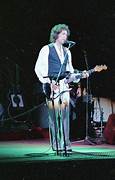
The narrator tries to be reassuring …You’re back where you belong… he tells her. But this does not seem to provide any consolation. In the extraordinarily self-deprecating lines: …Go get me my pistol, babe/ Honey, I don’t know right from wrong…he appears to be admitting that he has treated her appallingly. In recognition of this, he is preparing to shoot himself. Whether he does so is not revealed but the repeated pleas for her to … stop crying… in each of the four choruses appear to reveal that there is very little that, having let her down so badly, he can say to console her. Although he tries some reassurance in the unconvincing and rather obvious final line of the choruses: …You know and I know, the sun will always shine… this seems to do nothing to stop the flood of tears.

The narrator’s admonitions continue to be vague and unconvincing. …Go down to the river babe… he tells her …And I will meet you there… He even promises to ’pay her fare’, which, perhaps not surprisingly, appears to have no effect. Then, adopting a more soothing tone, he attempts to present himself as a friend: …If you’re looking for assistance, babe, or you just want some company/ Or if you just need a friend you can talk to/ Honey, come and see about me… But the genuine compassion for someone who is suffering, which had been conveyed so believably in an early song like To Ramona, is largely absent here. The attempt at empathy in the final verse is rather misplaced …You’ve been hurt so many times… the narrator tells her …And I know what you’re thinking of/ I don’t need to be no doctor babe, to see that you’re madly in love… This is rather patronising if, as we surely suspect, it is him who she is ‘madly in love’ with. It certainly does not stop her crying. As the song ends, his attempts to console her have clearly failed. The narrator seems – like so many classic blues singers – completely wrapped up in his own problems. Perhaps, in reality, it is he who finds it impossible to ‘stop crying’.
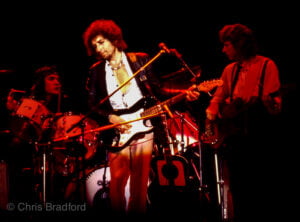
We Better Talk This Over is another song about a failed relationship. But rather than attempting to offer the woman any hope (which, as in Baby Stop Crying, he signally fails to do)the narrator merely informs her, in a rather chaotic and emotionally numbmanner, that their relationship is finished. The song has a deceptively attractive melody and the recordinguses another fulsome arrangement, even including an extremely unusual double tracked Dylan vocal. The backing vocalists echo many of the narrator’s sentiments, repeating line after line, which adds to the claustrophobic and rather detached tone of the song. The string ofrather shop soiled ‘splitting up’ clichés and mixed metaphors suggests that the narrator is trapped in a state of confusion, reduced to delivering increasingly weaker excuses for his own behaviour.
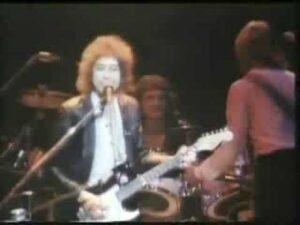
The song opens with the narrator and the woman feeling particularly depressed and suffering from a shared hangover. The narrator’sassertion that …I’m only a man, doing the best that I can… is rather pathetic.The way he rejects herin coldly detached language is particularly brutal…Why… he asks her …should we needlessly suffer?… He suggests that they should ‘go their separate ways’ …before we decay… an image which offers little consolation. When he sings: …You don’t have to be afraid of looking into my face/ We’ve done nothing to each other time will not erase…he seems to be implying that relationship has been basically meaningless and quite possibly mutually abusive.Then he descends further into maudlin self-pity. He informs us he feels ‘displaced’ and makes a brief accusation that she has been ‘double dealing’ (presumably ‘two timing’) him. He tells her, using a rather weird mixed metaphor, that …I’ve been caught in the trance of a downhill dance…addressingher rather condescendingly as ‘child’ and asking: …Why do you want to hurt me?… In a line that will soon prove to be ironic he adds: …I’m exiled, you can’t convert me…

True Love Tends to Forget is something of a conundrum. It is a more compassionate song but it still conveys a considerable degree of negativity and despair. Despite this, the song comes closer to a melodramatic pop style than any of his previous compositions. In some ways it even resembles the work of the perennially unfashionable but always popular Neil Diamond. The backing singers are used more sparingly here, mainly as support on the many repeated refrains at the end of every verse. It seems that the narrator is desperately trying to reassure himself that ‘true love’ is really a factor in this relationship. In reality he appears to be participating in another basically meaningless tryst, so much so that he is barely ‘present’ in terms of emotional engagement.
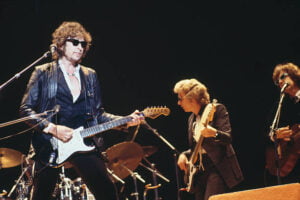
The song begins…I’m getting weary looking into my baby’s eyes… a clear reversal of a typical romantic cliché. …When she’s near me… he confesses …she’s so hard to recognise… Perhaps the narrator has had so many casual and meaningless affairs recently that his partners seem to him to be interchangeable. But something about her seems to have triggered some elements of his conscience. He declares that …I finally realise there’s no time for regret… Perhaps he has decided to be honest with this lover about how he really feels. But unfortunately it seems, from what follows, that he does not feel very much. Perhaps, however, he really does not know how he actually feels.
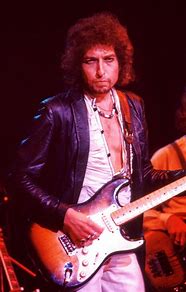
In the passionate and morally ambiguous Is Your Love in Vain, however, Dylan articulatessuch feelings in a powerful and more focused way. The rich musical texture, which builds towards a series of understated climaxes, strongly supports this. He expresses complex emotions in a way that few popular songs have ever done. The narrator does not present himself as a particularly enlightened or wise individual but the emotions he expresses come over as extremely authentic. Here Dylan carries out a forensic examination of the relationship between love and art.As many critics had pointed out over the years, his most memorable and resonant work had generally been produced when he himself was in the throes of personal chaos or bitter confrontation, as songs from Like a Rolling Stone to Positively 4th Street to Wedding Song and Idiot Wind bore witness. His ‘happier’ periods as a ‘family man’ living away from the limelight produced songs like Lay Lady Lay, If Not For You, Knockin’ on Heaven’s door or Watching the River Flow which certainly had their merits but could never match the songs written in ‘unhappy’ periods in terms of poetic imagination and revolutionary advances in the art of song.For Dylan, being in a happy settled relationship has proved to be virtually impossible to reconcile with reaching his artistic potential. Is Your Love in Vain confronts this dilemma head on, in a way that few songwriters have ever attempted.
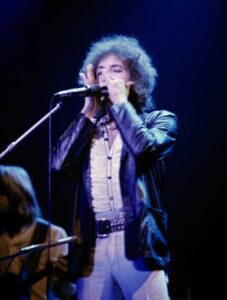
The language of the song is clear and forthright and is expressed in a stately and dignified tone.Whereas in some of the other Street Legal songs Dylan attempts to communicate through complicated metaphors, here he appears to be speaking directly from the heart. The opening couplet …Do you love me, or are you just extending good will/ Do you need me half as bad as you say, or are you just feeling guilt?… establishes an emotional distance from his lover as he questions whether her devotion is genuine. He sounds very wary of making a commitment, delivering the wonderfully compressed …I’ve been burned before and I know the score/ So you won’t hear me complain… He then asks a very direct question…Will I be able to count on you, or is your love in vain?…Such a clear expression of reticence is very unusual for a ‘love song’. The phrase ‘love in vain’ is the title of a brilliantly anguished blues classic by Robert Johnson, who laments the departure of his woman by reflecting back philosophically on his own state of mind. Dylan’s narrator maintains here that he will not be reduced to such desperate emotional dependence. But perhaps this is all bluster. The ambiguity of the address leaves room for interpreters of the song to tilt it in different directions. In Barb Jungr’s beautifully paced ‘stripped down’ version, which is performed in a tone of barely suppressed emotion over a solo piano, we sense that the narrator is merely pretending to be so detached. It is even possible to interpret the first verse as an address by the lover to the main narrator, with the rest of the verses being his response.



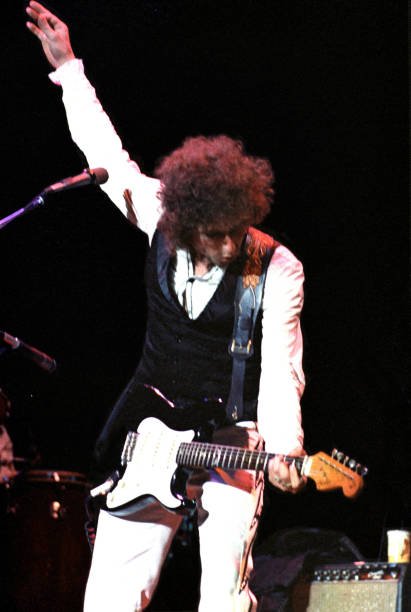
Leave a Reply